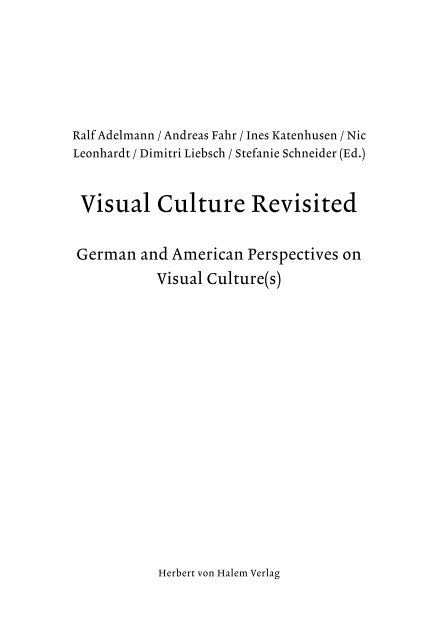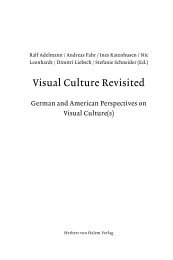Visual Culture Revisited
Visual Culture Revisited
Visual Culture Revisited
Create successful ePaper yourself
Turn your PDF publications into a flip-book with our unique Google optimized e-Paper software.
Ralf Adelmann / Andreas Fahr / Ines Katenhusen / Nic<br />
Leonhardt / Dimitri Liebsch / Stefanie Schneider (Ed.)<br />
<strong>Visual</strong> <strong>Culture</strong> <strong>Revisited</strong><br />
German and American Perspectives on<br />
<strong>Visual</strong> <strong>Culture</strong>(s)<br />
Herbert von Halem Verlag
Contents<br />
Preface 7<br />
i. production of knowledge in visual culture<br />
dimitri liebsch 12<br />
Pictorial Turn and <strong>Visual</strong> <strong>Culture</strong><br />
ralf adelmann 27<br />
Digital <strong>Visual</strong>izations and the Production of<br />
Knowledge in Television News<br />
jessica buben 40<br />
The Psychedelic Sewing Room<br />
ii. politics of pictures<br />
janusz kazmierczak 68<br />
The Politics of the <strong>Visual</strong> in the<br />
American Alternative Press of the 1960s<br />
stefanie schneider 81<br />
›Stop them damned pictures!‹ –<br />
Political Cartoons, <strong>Visual</strong> <strong>Culture</strong> and<br />
the Construction of Anglo-American Relations<br />
nic leonhardt 100<br />
Pictorial (Hi)stories – Illustrated Coverage of the<br />
Franco-Prussian War 1870/71<br />
andreas fahr 115<br />
Expressing the Inexpressible:<br />
u.s. and German Coverage of the School-Shootings<br />
in Littleton and Erfurt
iii. imaginary discourses – discourses of the image<br />
walter c. metz 127<br />
From Plato’s Cave to bin Laden’s:<br />
The ›Worst Sincerity‹ of Ron Howard’s<br />
The Missing (2003)<br />
bettina lockemann 141<br />
Constructing the World:<br />
Documentary Photography in Artistic Use<br />
claudia olk 153<br />
Vagueness, Vision, and the Veil –<br />
Perceptual Indeterminacy in Modernist Fiction<br />
iv. visual challenges to institutions<br />
ines katenhusen 173<br />
The ›Living Museum‹.<br />
The Work of Alexander Dorner (1893-1957)<br />
birgit däwes 194<br />
James Luna, Gerald Vizenor, and the ›Vanishing Race‹:<br />
Native American Performative Responses to<br />
Hege(mne)monic Image Construction<br />
v. image, identity, and alterity<br />
ingrid gessner 216<br />
Erasure and <strong>Visual</strong> Recovery:<br />
Displaying Japanese American Internment<br />
Experiences
steven hoelscher 243<br />
Photography as Social and Economic Encounter:<br />
The <strong>Visual</strong> <strong>Culture</strong> of Nineteenth-Century Native<br />
American Pictures<br />
geneviève susemihl 267<br />
The <strong>Visual</strong> Construction of the<br />
North American Indian in the<br />
World of German Children<br />
Contributors 292<br />
Register 298
Preface<br />
Every book has a history. Usually it is part of this history that editors have<br />
to pedal late contributors to hand in their texts, to find a good publisher,<br />
and to correct the manuscripts. Of course, this also applies to the book<br />
at hand. In 2003, conversations and discussions about and around visual<br />
culture led a Polish and several German academics to establish a network<br />
of interdisciplinary scholars. We had met at the Fulbright American Studies<br />
Summer Institute 2003 for Young University Teachers in Amherst,<br />
Boston and New York as representatives of a number of different fields,<br />
namely philology, social sciences, media and cultural studies, philosophy,<br />
theatre studies, art history and art. Soon, we were joined by several American<br />
scholars and the idea was born to organize the conference <strong>Visual</strong> <strong>Culture</strong><br />
<strong>Revisited</strong>. German and American Perspectives on <strong>Visual</strong> <strong>Culture</strong>(s). 1 Generous<br />
funding from the Fritz Thyssen Stiftung für Wissenschaftsförderung in<br />
Cologne, Germany, enabled us to meet at the hospitable John F. Kennedy<br />
Institut für Nordamerikastudien at the Freie Universität Berlin in April<br />
of 2005.<br />
This book features the articles based on the papers and challenging<br />
discussions at the Berlin conference. Its existence rests in large measures<br />
with the Fritz Thyssen Stiftung, to which we are again deeply indebted<br />
for generously subsidizing the printing costs. Regarding its content, the<br />
present collection of articles speaks to the multifaceted reactions that<br />
found expression in the different approaches to answer the questions<br />
1 We realize that the conference title did not give due credit to our Polish minority: Dear<br />
Janusz, please accept our belated but heartfelt apologies!<br />
7
preface<br />
that both guided and challenged us during our days in Berlin and the<br />
United States: Can we define visual culture in terms of general features,<br />
or are we bound to deal with visual cultures in the plural? How do different<br />
disciplines conceive of and represent divergent concepts of visual<br />
culture? How do they approach the phenomenon? Which impact does<br />
visual culture have on the notion of a collective memory? Furthermore:<br />
To what extent do visual media reference each other? Which commonalities,<br />
which differences between the various media should be highlighted,<br />
and what are the respective analytical consequences?<br />
The pop star Rod Stewart once wrote in a song that »every picture<br />
tells a story.« As the articles in this book exemplify, visual culture is in no<br />
way a singular phenomenon. Instead, there is a plurality of pictorial representations<br />
– from the sitcom to illustrations in children’s books, from<br />
cartoons to holograms. In this respect Stewart’s insight has to be complemented:<br />
Every type of image, every type of representation tells a different<br />
story. Furthermore, the articles published here challenge the naïve notion<br />
that there exists a uniform visual culture. Despite what a logocentric critique<br />
of images continuously insinuates, the visual dimension of cultures<br />
is ideologically not simplistic and definitely not homogenous. Rather,<br />
this dimension is itself – in the terms of Antonio Gramsci’s concept of<br />
hegemony – a contested field, a fact rendered visible in images of ›the<br />
Other‹ and pictures of Native Americans, for example. On one side, they<br />
are adopted by advertisers as exotic ingredients, while on the other side<br />
supplying a countercultural memory. Similar antipodes exist in respect<br />
to the location of images, as can be seen in the analysis of museums as<br />
institutions: What an image shows, where and in what context it is shown is<br />
also reason for argument and conflict.<br />
In five chapters – The Production of Knowledge in <strong>Visual</strong> <strong>Culture</strong>, The Politics<br />
of Pictures, Imaginary Discourses – Discourses of the Image, <strong>Visual</strong> Challenges<br />
to Institutions, and, finally, Image, Identity, and Alterity –, arguments and conflicts<br />
that these different discourses procure are pictured, examined, and<br />
analyzed. Within this scope, topics range from concrete case studies to<br />
reflections on the scholarly discourse of the ›iconic‹, ›pictorial‹ or ›imagic<br />
turn,‹ which has affected the debate since the 1980s. The articles deal with<br />
the question of which visualities prevail in mainstream culture and which<br />
are subsumed in notions of counter culture. They focus on the main paradox<br />
of visualization: enabling to comprehend the incomprehensible by<br />
visual means – to visualize the invisible. They apprehend the challenges<br />
8
that institutions are facing which highly depend on visuality, such as<br />
museums and theatres, and examine ways that have emerged to comprise<br />
recent media. And they altercate with a phenomenon that is too often sup-<br />
pressed in discourses on globalization: There is a clash within the visual,<br />
mirrored in the images that each of us carries in his or her head, adjusted<br />
in the collective memory: ›The Other‹ does not necessarily vanish when<br />
depicted as either exotic or folkloristic duplicate of ›our Own‹. Different<br />
sources – be they hegemonial or marginalized – provide for divergent<br />
depictions, controversial approaches and challenged concepts.<br />
As an enduring theme, controversy and challenge characterize all<br />
sections and articles of this book. This illuminates why it makes sense<br />
to talk about just one visual culture in spite of the plurality of different<br />
types of images. Images do not stand for themselves, and they also cannot<br />
be understood by themselves, instead they are included in (partly<br />
contradictory) practices. This holds true for both illustrations in and the<br />
layout of an underground journal and for the form and arrangement of<br />
mainstream tv. And this is the specific aspect of visual culture. With this<br />
credo, corroborated by our articles from divergent disciplines, this book<br />
takes a critical stance toward a more simplistic media theory as put forth,<br />
for instance, by Vilém Flusser, but also of attempts in the new German<br />
Bildwissenschaft. We are critical of such media theory because it is built on<br />
a determinism of media producing pictures instead of an understanding<br />
that conceives of such media mainly as a condition; and we are critical of<br />
the German Bildwissenschaft because its semiotic and phenomenological<br />
descriptions marginalize the (always also political) aspects of acting with<br />
and through pictures.<br />
The articles in this book provide not only a panorama of visual culture<br />
as an assortment of simultaneous and intersecting practices but also<br />
highlight the manifold references illustrating the complex embedment<br />
of visual culture in a historical perspective. In other words, without the<br />
knowledge of the ›God’s eye‹ metaphor there is no understanding of the<br />
political dimension of satellite photos, without Christian iconography<br />
no insight into the function of war photography. Insofar this book represents<br />
a plea for the practice that has been at the heart of this project:<br />
interdisciplinary work combined with transgressing the border between<br />
so-called ›high‹ and ›low‹ culture – in both directions.<br />
Finally, an intricate part of this book’s history is the editors’ experience<br />
that cooperation neither has to be built on a hierarchical structure<br />
9
preface<br />
nor relies on one particular place for its central coordination. Amazingly,<br />
whenever something had to be done someone was always there to do it.<br />
The time of this wonderful experience unfortunately – at least for now –<br />
is over. What stays with us is the deep insight that the idiom ›I got the<br />
picture‹ by no means is the last word, but rather marks only the beginning<br />
of new research.<br />
10<br />
Ralf Adelmann / Andreas Fahr / Ines Katenhusen / Nic Leonhardt /<br />
Dimitri Liebsch / Stefanie Schneider
















